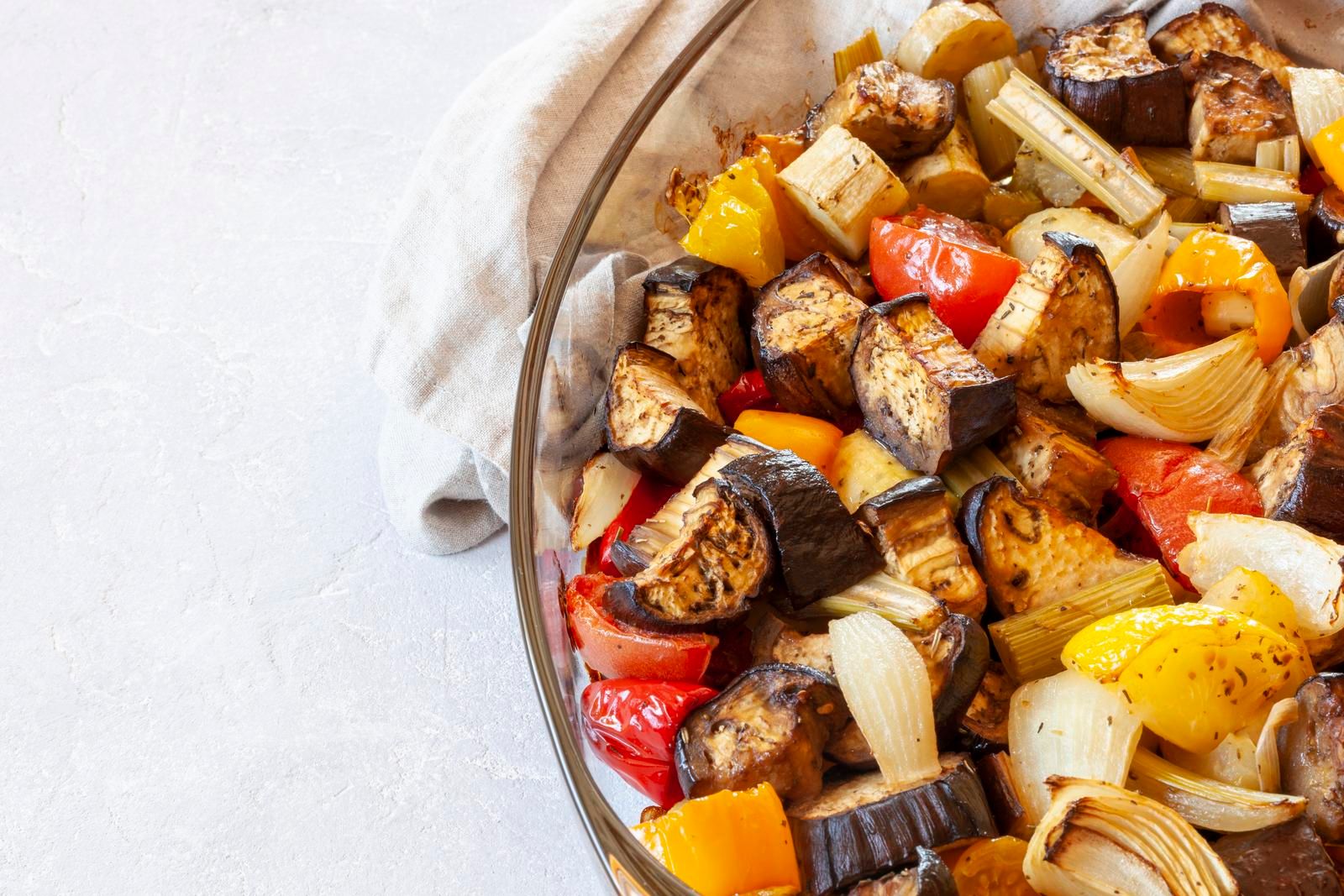Veggie Up: 12 Creative Ways to Eat More Vegetables

If you're like us, you know that eating more vegetables is essential for your health. However, it can be tough to fit them into your daily routine.
Whether it's because you don't like the taste, don't have time to prepare them, or simply forget to include them in your meals, we've got you covered with some easy ways to incorporate more veggies into your diet.
First, consider adding vegetables to meals you already love. For example, if you're a pasta lover, try adding some sautéed spinach, zucchini, or mushrooms to your dish. Or, if you're a sandwich fan, pile on some lettuce, tomato, and avocado to boost the nutritional value of your meal.
Another easy way to eat more veggies is to snack on them throughout the day. Carrots, cucumbers, and bell peppers are great options to munch on when you need a quick and healthy snack.
Also, consider having a vegetarian day once a week where you only eat plant-based food (including a lot of veggies!).
If you're feeling adventurous, try experimenting with new vegetables and recipes.
Roasting vegetables like Brussels sprouts, cauliflower, and sweet potatoes can bring out their natural sweetness and make them more appealing.
Or, try making a veggie-packed stir-fry with your favorite protein and some brown rice. With so many options out there, there's sure to be a vegetable and recipe that you'll enjoy.

Why Eating Vegetables is Important
We all know that vegetables are good for us, but do we really know why? Here are a few reasons why eating vegetables is important for our health:
Vegetables are packed with essential vitamins and minerals that our bodies need to function properly. They are also a great fiber source, which helps keep our digestive system healthy and regular.
Eating a diet rich in vegetables has been linked to a reduced risk of chronic diseases.
Vegetables are low in calories and high in nutrients, making them a great choice for maintaining a healthy weight and reducing inflammation in the body.
Vegetables are incredibly versatile and can be prepared in a variety of ways, making it easy to incorporate them into our daily diet. Whether you prefer them raw, roasted, steamed, or sautéed, there are endless possibilities when it comes to adding more vegetables to our meals.
So, if you want to improve your overall health and well-being, consider adding more vegetables to your diet.
Not only will you be doing your body a favor, but you'll also be enjoying delicious and nutritious meals in the process.
How to Incorporate Vegetables into Your Meals
Incorporating Vegetables into Breakfast
Starting your day with a healthy dose of vegetables can set the tone for the rest of your day. Here are some easy ways to incorporate vegetables into your breakfast:
- Add spinach, kale, or other leafy greens to your morning smoothie
- Make a veggie-packed omelet with peppers, courgettes, mushrooms, and spinach
- Top your toast with avocado and sliced tomatoes
- Add a scoop of powdered greens to your smoothie, omelet, or even porridge
Incorporating Vegetables into Lunch
Lunch is a great opportunity to get in some more vegetables. Here are some ideas:
- Make a big salad with lots of veggies like carrots, cucumbers, and bell peppers
- Swap out your sandwich bread for a lettuce wrap
- Whip up a quick salad dressing from an avocado, a bit of olive oil, a dash of lemon juice, and a pinch of salt
- A vegetable soup is a great way to cover your serving of vegetables for the day - tomato soup, carrot soup, broccoli soup, butternut squash soup - the list goes on. Experiment and you are sure to find a soup that you love.
Incorporating Vegetables into Dinner
Dinner is often the biggest meal of the day, so getting in plenty of vegetables is important. Here are some ways to do that:
- Roast a big tray of mixed vegetables like zucchini, eggplant, and bell peppers
- Add some chopped kale or spinach to your pasta sauce
- Make a stir-fry with lots of colorful veggies like broccoli, carrots, and green beans
Incorporating Vegetables into Snacks
Snacks are a great opportunity to sneak in some extra vegetables. Here are some ideas:
- Snack on raw veggies like carrots, celery, and bell peppers with hummus or another dip
- Make some kale chips by tossing kale with olive oil and baking until crispy
- Blend up some veggies like carrots and beets into a delicious smoothie
Tips for Preparing Vegetables
Washing and Prepping Vegetables
Before we can enjoy the benefits of vegetables, we need to clean and prepare them properly.
- Wash vegetables thoroughly with cool running water. Use a vegetable brush to scrub tough-skinned vegetables like potatoes and carrots
- Peel vegetables with tough skins like cucumbers and zucchinis
- Cut vegetables into uniform sizes to ensure even cooking
- Remove any bruised or damaged parts of the vegetables before cooking
Cooking Vegetables
Cooking vegetables can be done in many ways, depending on the type of vegetable and your personal preference. Here are some cooking methods to try:
| Cooking Method | Vegetables to Try |
|---|---|
| Boiling | Broccoli, Cauliflower, Carrots, Potatoes |
| Steaming | Asparagus, Green Beans, Brussels Sprouts, Carrots |
| Sautéing | Mushrooms, Bell Peppers, Onions, Zucchini |
| Roasting | Beets, Carrots, Sweet Potatoes, Squash |
Seasoning Vegetables
Seasoning vegetables can make them more flavorful and enjoyable to eat. Here are some seasoning ideas:
- Sprinkle vegetables with herbs like basil, thyme, oregano, or rosemary. You can use fresh or dried herbs. Not only will this enhance the taste of your vegetables but the herbs themselves have many compounds beneficial for our health.
- Add a squeeze of lemon or lime juice to brighten up the flavor
- Drizzle vegetables with olive oil or melted butter for added richness
- Try seasoning vegetables with spices like cumin, paprika, or chili powder

Variety is Key
When it comes to eating more vegetables, variety is key.
Eating the same vegetables every day can get boring, and it can also limit the nutrients that we get from our food. Here are a few ways to add variety to your vegetable intake:
Different Types of Vegetables
There are many different types of vegetables out there, and each one has its own unique flavor and nutrient profile. It is important to eat a variety of vegetables Some of our favorites include:
- Leafy greens like spinach, kale, and arugula
- Cruciferous vegetables like broccoli, cauliflower, and Brussels sprouts
- Root vegetables like carrots, sweet potatoes, and beets
- Nightshades like tomatoes, eggplant, and peppers
- Alliums like onions, garlic, and leeks
Seasonal Vegetables
Eating seasonally is a great way to add variety to your vegetable intake. Not only does it help you try new vegetables, but it can also be more affordable and environmentally friendly. Some seasonal vegetables to try include:
| Season | Vegetables |
|---|---|
| Spring | Asparagus, artichokes, peas, radishes |
| Summer | Zucchini, tomatoes, corn, bell peppers |
| Fall | Pumpkin, squash, sweet potatoes, Brussels sprouts |
| Winter | Kale, broccoli, cauliflower, carrots |
Trying New Vegetables
Trying new vegetables can be intimidating, but it's a great way to add variety to your diet. Here are a few tips for trying new vegetables:
- Start with small amounts and work your way up
- Try different cooking methods (roasting, grilling, sautéing, etc.)
- Experiment with different seasonings and sauces
- Ask for recommendations at your local farmers' market or grocery store
Final thoughts
By incorporating more vegetables into our daily diet, we can improve our overall health and well-being. Not only are vegetables packed with essential vitamins and minerals, but they are also low in calories and high in fiber, making them an excellent choice for weight management.
There are numerous ways to add more vegetables to our diet. We can start by incorporating them into our favorite dishes, such as adding spinach to our morning smoothie or topping our pizza with roasted vegetables. We can also experiment with new recipes, like making zucchini noodles or trying a vegetable stir-fry.
Another way to increase our vegetable intake is by snacking on them throughout the day. We can cut up some carrots, celery, and bell peppers to snack on during the day or dip them in hummus for added flavor.
Lastly, we can make a conscious effort to choose vegetables as our main dish. We can make a big salad with lots of veggies or try a vegetable-based soup or stew for a hearty and nutritious meal.
By following these tips, we can easily incorporate more vegetables into our diet and reap the numerous health benefits they provide.


